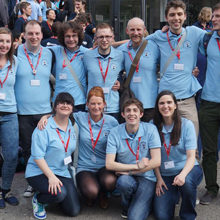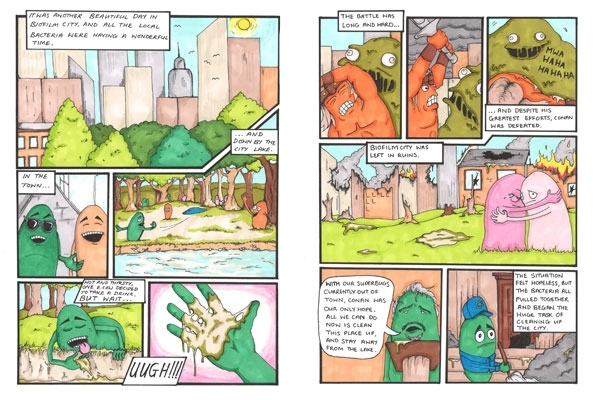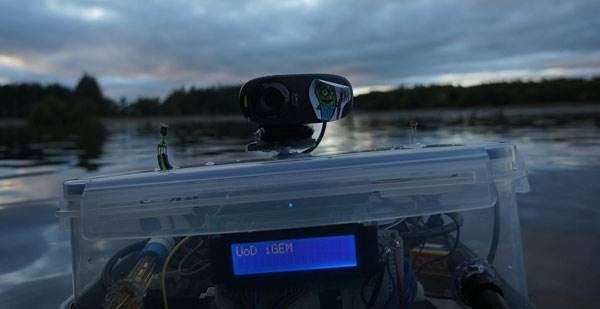Comment: Winning University of Dundee iGEM team
Issue: Real superheroes
25 February 2014 article

The summer of 2013 was wonderful in Dundee, with temperatures soaring to 29°C. I didn’t see much of the glorious weather though as I was experiencing one of the best times of my life – when I took part in the International Genetically Engineered Machine (iGEM) competition last year.
The International Genetically Engineered Machine (iGEM) competition is a synthetic biology competition run by the not-for-profit iGEM Foundation based in Cambridge, Massachusetts, USA. The competition is split into undergraduate and ‘overgraduate’ (postgraduate) categories. Teams from across the globe compete in regional jamborees for the chance to go to Boston, Massachusetts, USA, for the World Finals.
I was lucky enough to be chosen as a member of the undergraduate Dundee University iGEM team as one of six life scientists: there were also two mathematicians, a physicist and a software engineer. Our interdisciplinarity was invaluable, offering a different approach to every problem we faced. We tackled each problem as a team and everyone had their say. This meant our meetings lasted hours but good decisions – that enhanced our project – were made.
We knew that we would be competing against some of the best universities in the UK, Europe and the world. Nonetheless, we thought that if we could develop a neat idea we would be competitive and proudly represent the city and University of Dundee in the World Finals in Boston. This was very important to us as 8 out of 10 iGEM members were born in the Dundee area.
Our project was entitled ‘ToxiMop’ and it focused on tackling the problem of toxic blue-green algae. Blue-green algae, or cyanobacteria, are thought to be one of the first organisms to have colonised early Earth. When conditions in freshwater systems (including sources of drinking water) become favourable an explosion in the numbers of cyanobacterial cells, called an algal bloom, can occur. Unfortunately, these blooms produce toxins that are harmful to the health of many eukaryotic organisms, including livestock and humans. Our team targeted the liver toxin microcystin, which is made by cyanobacteria. Microcystin is toxic because it binds to and blocks the function of protein phosphatases, including PP1, found in eukaryotic cells.

We took advantage of the microcystin/PP1 interaction to develop a bacterial mop using Escherichia coli; a ‘ToxiMop’. Since microcystin does not freely diffuse into the cytoplasm of E. coli we had to target PP1 to the periplasm of the cells. This was achieved by engineering the PP1 so that it was transported across the inner membrane by the twin-arginine translocation (Tat) pathway. When the ToxiMop cells were exposed to high levels of toxin, comparable to those found in contaminated drinking water samples, the microcystin was pulled out of the solution, yielding water that is regarded as safe by the World Health Organization. In addition to a biological mop, we began developing a detector for microcystin, the ‘Moptopus’, which can monitor environmental conditions at the surface of a water body. The Moptopus (below) works as an early-warning system to indicate when and where to deploy ToxiMop. Future plans include using this device to relate environmental conditions to toxic algal bloom formations.

In total, 204 teams from around the world entered into the various categories of the iGEM competition, with 13 UK universities being represented. As part of the competition all teams are asked to present their projects. A website, poster and a 20-minute talk had to be created by each team. When our team arrived in Lyon for the European Championship we were overwhelmed by the number and professionalism of the other teams. We were totally shocked when we were announced as one of three finalists on the final day. Our disbelief continued when we were announced as winners of the European Championship! Not only that but we won a prize for the best presentation: we were going to the World Finals in Boston along with a number of other teams from each of the World Regional Championships.
In the USA our success continued. We won the prize for best presentation again, but the highlight was winning the iGEMer’s Prize for the favourite team as voted for by all 80 teams. Winning this confirmed we had made our supporters in Dundee very proud.
I have had exposure to the research environment a number of times during my undergraduate career but iGEM was a richer, more complete experience. As well as practical lab experience, we had to run our own lab and buy all our reagents. Additionally, I will take forward the extensive presenting, poster-making and lab experiences into my PhD. In addition, appearing on Scottish Television News as well as BBC News provided invaluable training in communicating with the media and learning how to make microbiology accessible to the wider public.
Finally, my advice to anyone thinking about joining their university’s iGEM team next year is – do it! If your university doesn’t have a team ask your professor to apply for funding. You will have to work hard but you will have a great time and learn an incredible amount.
CHRIS EARL
Division of Molecular Microbiology, College of Life Sciences, University of Dundee, DD1 5EH, UK
[email protected]
Chris undertook a degree in Molecular Biology at the University of Dundee. He graduated this summer and has just started a PhD examining the role of the lung microbiome in asthma.
Image: (from top): The University of Dundee iGEM team in Lyon. The Motopus, Nasir Ahmad & Kyle Harrison. Pages from the comic developed by the iGEM team as part of their project. Avril Smart..


